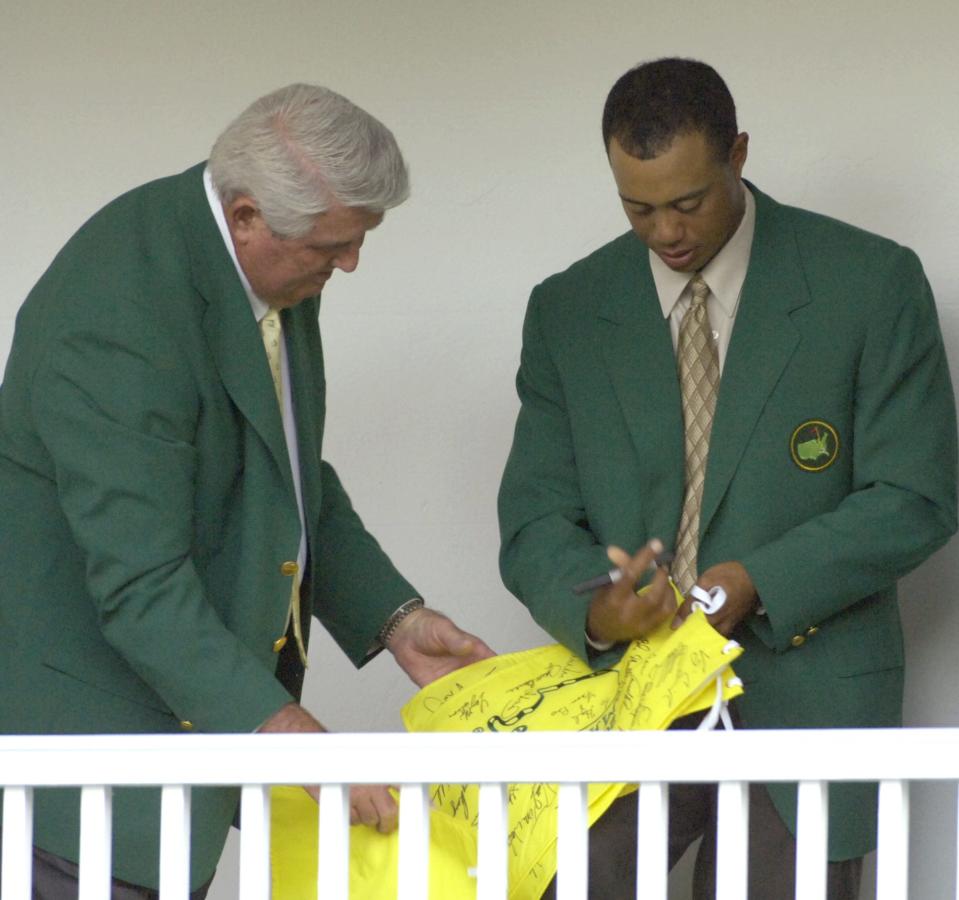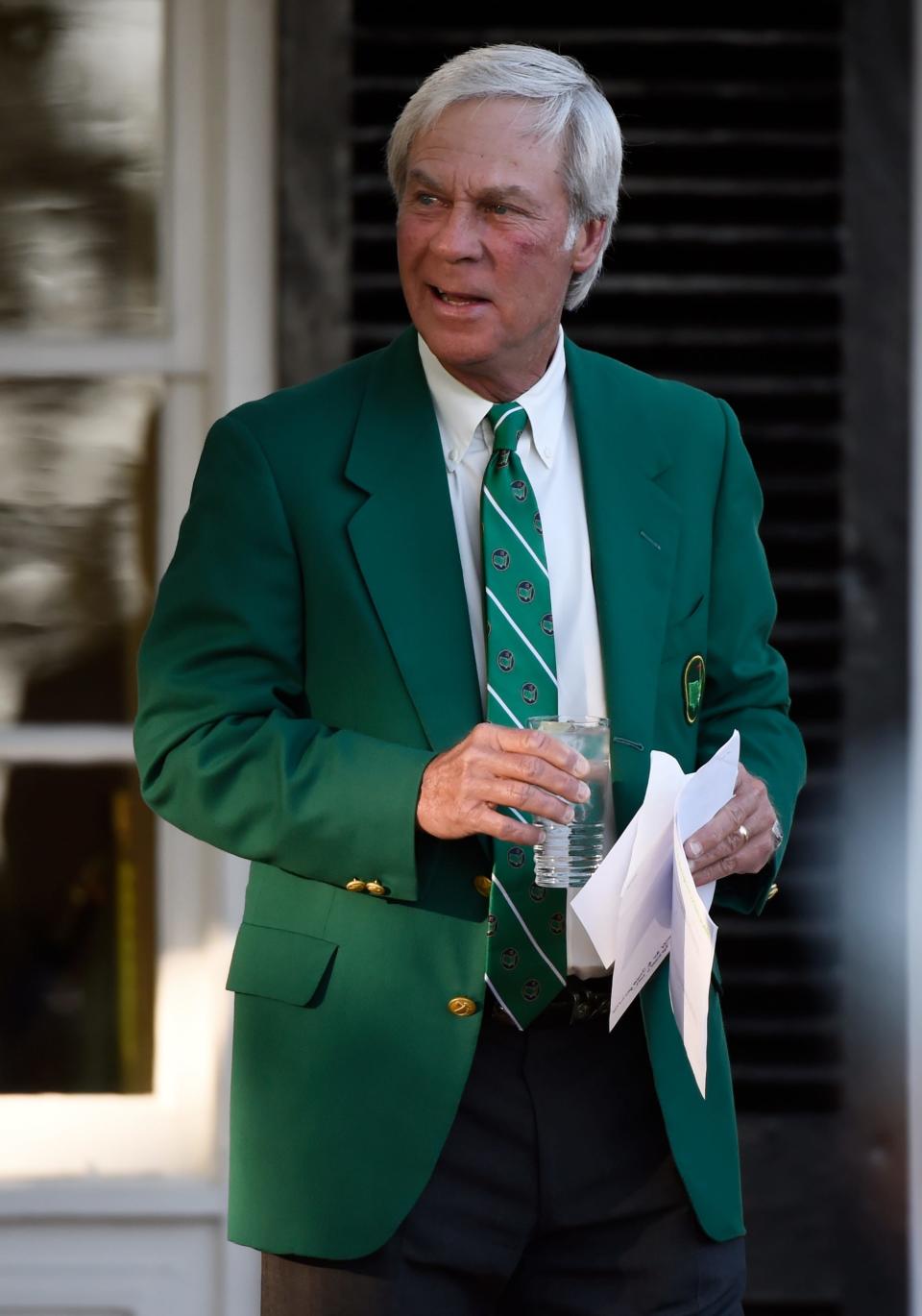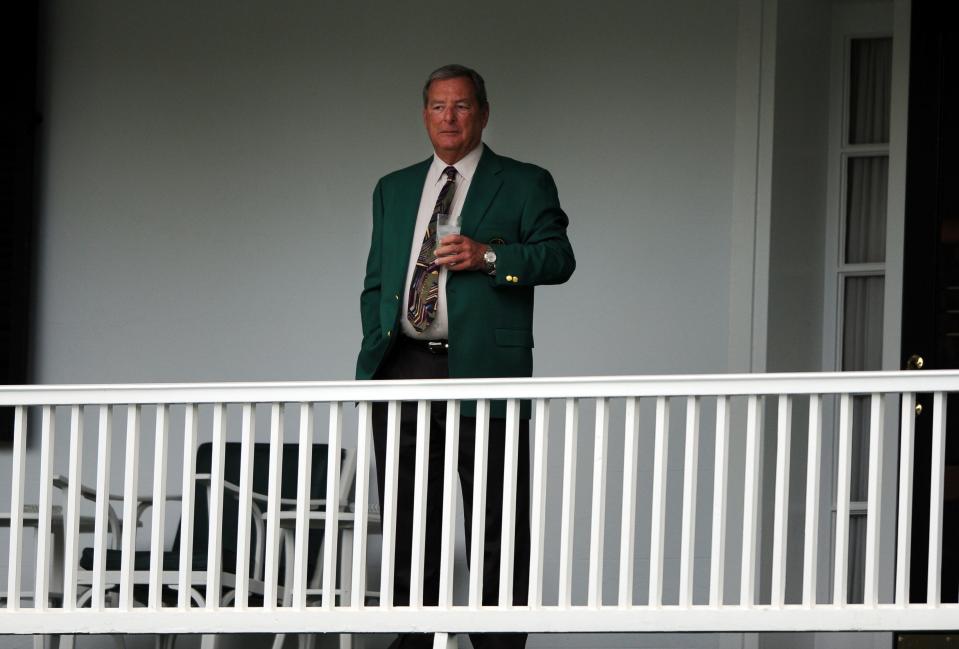Champions Dinner at 70: Tuesday night tales now tradition at Masters
Suzanne Radcliffe turned onto Magnolia Lane and made her way towards Founders Circle. The clock inside the silver Mercedes glowed 9 p.m., but her boyfriend, Fred Couples, was nowhere to be found.
It was April 9, 2019, and Couples believed that Tuesday’s Champions Dinner would conclude on time.
“Every year we end at 9 o’clock sharp,” he said.
Except for 2019, when laughter inside the clubhouse echoed through the second floor. It started when Bob Goalby rattled off a tale about Ben Hogan, and now the floodgates were coming loose.
Soon after, Gary Player rose from his chair and recalled his night of induction. After the 1962 meal was served, two-time champion Horton Smith requested the table sign his menu and passed it to Player. When Gary slid the paper to Hogan, the steely-eyed Texan glared at the room and struck the table with his right fist.
Fan experience at the Masters: What you need to know at Augusta National
Matsuyama's menu: Here's what's on the menu for Hideki Matsuyama's 2022 Masters Champions Dinner
Who wears the pants at Augusta National?: Talor Gooch, eventually, after fashion faux pas
More: Augusta National is over 7,500 yards for the first time. How will it impact the 2022 Masters?
Hideki Matsuyama: Masters title enhances Japanese history in men's golf
“This is the Masters Club dinner,” Hogan said. “Not a goddamn autograph session.”
As Player retold the story, the 2019 gathering let out a deep laugh, and for a brief moment, the old-timers had delivered a taste of yesteryear.
Jackets and jokes create an unforgettable experience

Seventy years ago, on March 31, 1952, Hogan drafted a letter suggesting a stag dinner be held for all previous champions, with honorary invitations to club president Bobby Jones and chairman Clifford Roberts. The dinner would be held the Friday of Masters Week, beginning promptly at 7:15 p.m.
“My only stipulation,” Hogan wrote to Roberts, “is that you wear your green coat.”
The Masters Club began with 11 members, and as the group grew, so did its levity. By the 1960s it was a who’s-who of storytellers, and even today, the highlight for many remains the tales.
“What you hear inside that room, you just don’t hear anywhere else,” 1979 winner Fuzzy Zoeller said.
At the infancy of the dinner, three-time winner Jimmy Demaret would often become the center of attention. According to Tommy Aaron, at the 1974 supper, Roberts was discussing his soon-to-be published book when Demaret interjected.
“So, Cliff,” Demaret said. “Will this come in hardcover or paperback?” The room filled with nervous laughter, as Roberts quickly put Demaret back in his place.
Others pinpoint Claude Harmon as the life of the party. Harmon was a club professional who entered 1948 without a Tour victory, and only touring professionals had won the first 11 Masters. All these Aprils (and one November) later, and a touring pro has exited Magnolia Lane wearing green ever since.
The lone exception was Harmon, a strong-shouldered 31-year-old who spent winters at Seminole Golf Club and exhausted the remaining months at Winged Foot.
Harmon entered Sunday with a two-stroke lead but, after playing Nos. 6, 7 and 8 in four-under par, the blue-collared pro had boatraced the field.
“There was nobody funnier than Claude Harmon,” said 1976 winner Raymond Floyd. “He’d tell a story one year and we’d all laugh. The next year he’d tell the same one and it would be ten-times more embellished.”
Tom Watson agreed, saying, “Claude Harmon was the best. He could talk for an hour about how golf was in the 1930s and '40s.”
For Ben Crenshaw, his favorite Harmon story centers on a moment at River Oaks Country Club in Houston. Dickey Harmon, one of Claude’s four sons, was the head professional and his old man would visit for three weeks at a time.
During a 1980s stay, Claude noticed the pro shop was overflowing with Featherlite irons, a Dave Pelz invention that Dick believed would monopolize the industry. Claude snatched one like a toothpick, waved it through the East Texas air. According to Crenshaw the dialog went as follows.
“What the hell is this Dickey?” Claude said.
“Dad, they’re going to take over golf,” Dick replied.
“I’m not so sure, Dickeyboy.”
Claude believed head weight was crucial to success, and before long the father and son had migrated to the rear of the shop to weigh clubs. The device was similar to a medicine scale, sliding a top marker from left to right until balanced. This version weighed by letters, not numbers. Dick attached the Featherlite, inched the knob before it rested on B. When Claude threw on his trusted brassie, the scale tilted from A to B to C to D, finally coming to terms at a density of E Zero.
“You won Augusta with that?” Dick shouted.
“I only won by five, Dickeyboy,” Claude said. “Only won by five.”
At the first Champions Dinner, nine winners were in attendance with the exception of 1939 champ Ralph Guldahl and 1946 winner, Herman Keiser. Hogan served as host, paid the bill, while the table reminisced on the brief 18-year history of the event. Also, the men brainstormed ways to improve the tournament. A suggestion from Byron Nelson was to assist in finding worthy competitors to join the field. Roberts, who unapologetically considered Nelson his favorite, embraced the idea.
Over the ensuing decade, Roberts annually mailed pre-written pieces of Augusta National stationery where nominations could be made for one American professional, one foreign professional and one amateur to compete. Demaret suggested that Peter Thomson, his Australian buddy, receive an invitation in 1953. Hogan and Nelson vouched for amateur Ken Venturi in 1956, who placed runner-up to Jackie Burke.
Menu, participants always changing over the years
The Champions Dinner remained on Friday for seven years before pivoting to Tuesday in 1959. Changes have been a staple over the past seven decades, with the most obvious being the menu.
At the beginning, the Masters Club was given three options: steak, chicken or fish. Since the mid-1980s, champions have picked their own meal, including 1989 when Sandy Lyle shocked the table with haggis, the national dish of Scotland. The grub is composed of the liver, heart and lungs of a sheep.
“I usually respect what the host picks,” said Larry Mize, who served steak and peach cobbler in 1988. Mize ate the chicken panang curry from Vijay Singh in 2001. He didn’t balk at the braai served by Charl Schwartzel or Trevor Immelman’s bobotie.
“Only once did I order something different,” Mize said. “I couldn’t do Sandy’s haggis.”
Also rotating has been the head of the table. Although the dinner is annually hosted by the previous year’s winner, Hogan believed there should be a moderator, someone to open the evening before others chimed in with tales of their own.
Hogan emceed the first four years until handing the reins to Nelson, the more natural storyteller. Byron held rank until after the 2004 Masters.
On a winter evening in early 2005, Crenshaw was sitting in his home library in the hills of Austin, Texas, when the phone rang. The 1984 and 1995 winner answered and recognized the 1937 and 1942 champion on the other end. Nelson had given no premonition to his request, but at age 93, Byron knew it was time.
Nelson explained how he always admired Crenshaw’s knowledge of golf history – in particular Jones and the Masters Tournament. Byron said that he had given thought to this conversation and asked if Crenshaw would take over the dinner.
“The phone fell out of my hand,” Crenshaw said. “Byron said, ‘What was that?’ I said, ‘I’m sorry, Mr. Nelson. I dropped the phone.’”
Two years after creating the dinner, Hogan drafted a second letter to Jones and Roberts, dated Jan. 12, 1954. Hogan began by telling the co-founders that he received his invitation to the tournament, and then addressed the significance of the Masters Club.
“This has to be the most exclusive club of all,” Hogan scribed. “Not only do a fortunate few of us have the tournament to look forward to, but the annual meeting of our club as well. Here, long after serious competition for some of us comes to an end, we can still get together and reminisce.”
Yet by the 1970s, the group's actions no longer mirrored those words. While Nelson was a Tuesday mainstay, other native Texans had spotty attendance records.
Ralph Guldahl, with curly hair and bad posture, skipped the first 12 before making an appearance in 1964.
Demaret partook in the first 16 until Jones was notified of a 1967 Houston Press article, in which Jimmy had criticized the Masters. Jones wrote a hand-slap response, leading Demaret to skip the next six years. Hogan missed his first dinner in 1968, and after he and Demaret broke bread with the club in 1978, neither returned. Demaret died in 1983; Hogan in 1997.
Finally, there’s 99-year-old Jackie Burke, who has missed more reunions than any living champion.
In 1972, the Masters was prepared to hold its first tournament since the December death of Jones, yet the 1956 champion declined his invitation. Roberts reached out to emphasize the importance of Tuesday’s dinner, and when Jackie didn’t budge, Hogan phoned with a similar message.
It didn’t matter. Burke’s home course in Houston, Champions Golf Club, was without an active manager and he shouldered those duties.
“My wishes will be for another successful Masters,” Burke wrote to Roberts. “With your guiding hand, it can’t miss.”
Burke hasn’t returned to Augusta National since 2011, and his programmed response is to blame the travel. He listed the fuss of getting to the Houston airport, the flight to Atlanta and the Interstate 20 commute to Augusta. For one supper? It isn’t worth the hassle, Jackie stated.
“I got $6,000 for winning the tournament and now they’ll pay me $10,000 to show up for dinner,” Burke said.
When pressed to expand on his prolonged absence, Burke admitted, “The truth is, my friends aren’t there anymore. Hogan, Jimmy, all of my friends are gone.”
As new blood arrives, humor becomes more modest
As time has elapsed, details from Tuesday evening have often clouded.
Was it 1985 or ’86 when Palmer and Hardin squared off over the cut of the 13th fairway? Was chicken or fish Gene Sarazen’s dish of choice? (Zoeller swears it was fish.) What one-liner did Demaret reel off in 1978 that caused the table to howl?
Many tales have been forgotten; others won’t leave the room. Yet ask a former champion about his night of induction to the Masters Club and memories seem to flood.
During his evening as host in 1980, Zoeller brought gag gifts as an attempt to quiet his nerves. Following the meal, he reached into a white bag and handed a bottle of Grecian Formula to Arnold. The gray-headed King burst into laughter, prompting the new champion to say, “Arnie, I can’t handle you getting old.”
For Watson, it was 1978 when Hogan bestowed upon him the annual induction gift. It’s a gold locket in the shape of Augusta National’s emblem that opens three ways, dons an image of the clubhouse, and reads, ‘Ben Hogan, founder of the Masters Club.’ It was the final time Hogan presented the keepsake, a task that now belongs to Crenshaw.

When asked if he was more nervous on Sunday in 1976 or Tuesday of ’77, Raymond Floyd said, “I didn’t really get nervous on the course, but that Tuesday in 1977, I was like a whore in church.”
If hosting the dinner triggered the most clarity, not far behind were memories of Sam Snead.
Snead’s appointed role was to close the dinner. After the meal had ended and the stories wound down, Nelson would grant Snead the last word. The Slammer would rise from his chair, release a Virginia Hill Country smirk, and tell the table an unrestrained joke.
How inappropriate were the cracks? According to Jack Snead, the Slammer’s oldest son, he believes it’s why his father never received a namesake landmark at Augusta National. Nelson, Hogan and Sarazen had bridges dedicated in the 1950s, yet Snead, with more jackets than each, was bypassed.
“I really believe his jokes played a role in that decision,” Jack said.
By the mid-1970s, when skipping dinner was a pattern for Burke, defending champion Jack Nicklaus mailed him a note in 1976 asking the Houstonian to attend.
“I will be there all dressed up in green,” Burke wrote back to Nicklaus. “Need a putting tip this year and no Snead stories.”
No past champion would spill a Snead joke. Floyd admitted, “I don’t feel comfortable telling them to another man.”
“Were they the worst I ever heard?” Fuzzy asked himself. “Yeah, probably so.”
“I’m not going to repeat any,” Larry Mize said. “I can’t.”

“Oh, I remember a few,” Charles Coody said. “But I don’t feel comfortable repeating them.”
Today, there’s no appointed joke teller. Ian Woosnam attempted to seize the moment once, but hasn’t stepped up again. For some, including Mize, he believes the table is doing well without the added humor. Zoeller, however, thinks otherwise.
“I told Ben, ‘If you call on me, I’ll do it,’ ” he said. “Crenshaw, you know, he put his head down and laughed. I guess it’s kind of like school. I didn’t get called on there, either.”
This article originally appeared on Augusta Chronicle: Masters Champions Dinner: An inside look at the annual tradition

